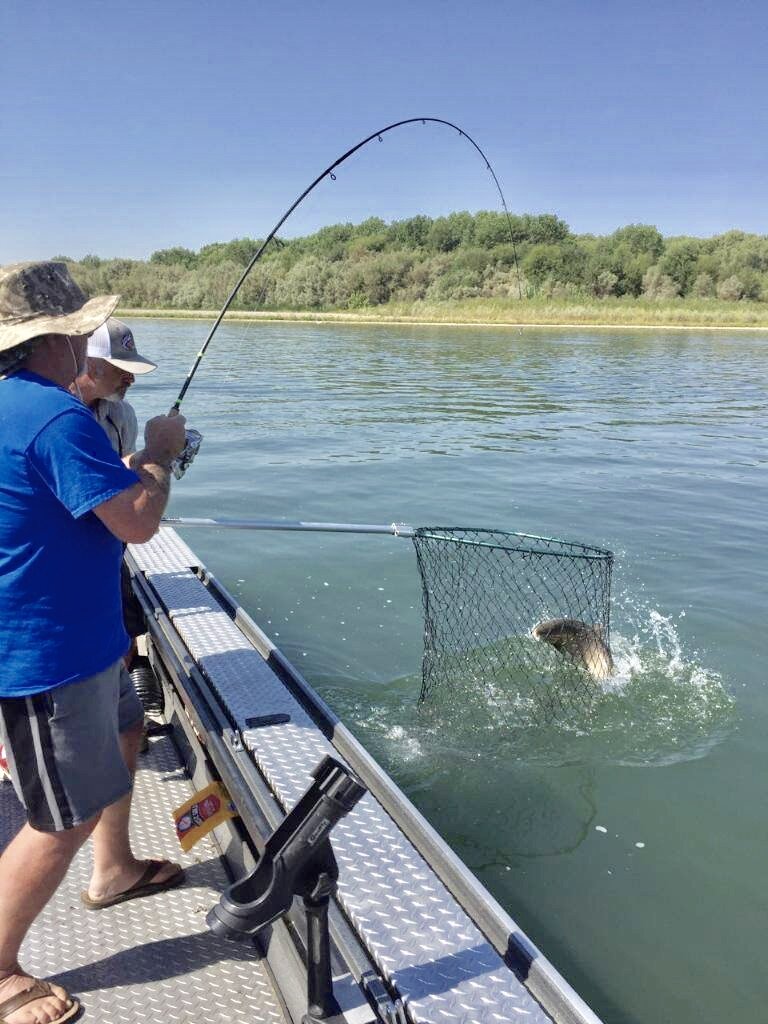Sacramento River King salmon caught while side drifting eggs with spin gear from a power boat.
SACRAMENTO RIVER KING SALMON FISHING
The technique of drift fishing for King salmon from a boat has many names but for the most part, the presentations are all the same. Drift fishing is best described as the natural presentation of baits to salmon, trout and steelhead holding in certain sections of the river. Salmon and steelhead holding near the rivers bottom will readily take a small cluster of salmon roe (eggs) as it drifts naturally with the current in front of them. Salmon and steelhead will grab the cluster of eggs as it passes by them and when your line goes tight, its fish on!
SIDE DRIFTING FOR KINGS FROM A BOAT
Side drifting for King salmon from a boat on the Sacramento River is deadly because its a technique that provides for the very best natural presentation of your baits to the salmon. Not only does this technique allow for a flawless presentation, the amount of holding water that you can cover numerous times in any drift is unmatched by any other technique. Side drifting isn’t the easiest technique to perform and requires pretty good boat handling skills. Its the boat operators job to position the boat in such a manner that the bow is pointed upstream, but also to control the boat so it is drifting downstream at the same speed as the current. Its very important that the baits drift through King salmon holding water at the same speed as the river current so it makes the baits look like they are drifting along the river bottom naturally. If you can’t match current speed, its better to create a slower presentation than one thats much faster than the actual current speed.
Once you position your boat at the top of the drift and your boat is slipping downstream with the current, anglers in the boat need to cast upstream at a 45 degree angle. The angler nearest the back of the boat should cast first, and then subsequent anglers should make their casts above the last anglers cast. This is easily accomplished with a few people in the boat, but when there are several anglers casting, it can get tricky. As long as the boat operator maintains a proper positioning of the boat , and the anglers cast upstream in order from back to front, the drift has a good chance at success. Once the section of fishable water has been covered from top to bottom, the lines are reeled up and the boat driver heads back to the top of the drift. Repeat, repeat, repeat, until one of your baits finds a bite from a King salmon. Fish on!
BOONDOGGING FOR KINGS FROM A BOAT
Boon dogging is also considered drift fishing from a boat, but boat positioning and control is completely different. Many people also refer to this technique is dragging and thats actually a good description. In this technique, the boat operator positions the boat at the top of the drift, but instead of pointing the bow upstream, the boat is positioned perpendicular to the shoreline. The boat driver positions the boat over the slot where King salmon will be holding and the anglers in the boat will cast their baits off the upstream side of the boat. I always position my boat so the port (left) side of the boat is facing upstream. Anglers cast upstream and essentially drag their baits through the drift. The boat generally drifts downstream at current speed, giving the baits a natural presentation to the King salmon holding on the bottom of the river. This technique is the most popular technique for bait anglers who like to drift bait for King salmon on the Sacramento River.
BEST DRAGGING/SIDE DRIFTING WATER
So now that you have a general idea of how to drift fish for King salmon from a boat, its only an effective technique if you are presenting baits to King salmon holding on the river bottom. Reading water is an art and takes many years for most to become really good at understanding where the salmon will be holding in a certain section of a river. Generally speaking, King salmon on the Sacramento River like to hold in 10’-20’ of water. Slower moving, deep sections of the river provide a resting area for traveling King salmon and also afford them a sense of security to some degree. Shallow, fast moving water will hold King salmon if they are pushed there by fishing pressure, but these sections of the river are considered travel water. King salmon swim quickly through shallow water until they reach the next deep, slow moving water hole.
I look for a long section of river that has water in the 10’-20’ depth range and has a relatively flat bottom. The top of the drift usually has a shallow section of river above it and has a shallow water section at the end of the drift as well. Somewhere in the drift there will be adequate depth with the proper amount of flow and it will hold migrating Sacramento River King salmon. These areas can often times be identified by the current seam. A current seam is where faster moving river current brushes against the slower water section of the drift. This is a sweet spot for the salmon and they can often times be found holding there. The top of the drift will also hold King salmon. The salmon will nose up to the top of the drift where deeper water meets shallow water coming down river. Moving salmon will often times be found in this section of the Sacramento River before they shoot through the shallow water up into the next hole. The same can be said for the tail end of the drift as well.
ROD AND REEL SELECTION
I prefer to use 9’-9 1/2’ G.Loomis spinning rods and favor the E6X series for their price point and durability. They are very well suited for drift fishing from a boat for Sacramento River King salmon. The longer rods give my client anglers many advantages while fishing with the G.Loomis E6X rods. Longer rods provide lots of casting control and distance, tip sensitivity, power for good hook sets, and power for fighting big salmon to the net. Its also much easier for me to watch client rod tips which often leads to me letting a client know he or she is getting bit! The two G.Loomis E6X models I recommend are the STR 1145S and the STR 1084S. I’ve caught many salmon on both rods and the other Captains on my team use them as well.
The Shimano 4000 series spinning reels are our choice for use when Sacramento River King salmon fishing. These reels have more than enough drag to wear out big King salmon and hold plenty of line to play with when fighting a hot King salmon thats taking long, line peeling runs. There are many models to choose from, but I would say that skimping on price here is not advisable. A good drag and a stout frame are important when fighting big fish. I prefer the Shimano Nasci or Stradic 4000 series reels spooled with 15 pound PLine CX Premium. I’ve used these reels and line combos for years and they always do a fantastic job and perform the way I need them to.
TERMINAL TACKLE
What goes on the end of the line is just as important as the rod and reel you use for King salmon fishing on the Sacramento River. I use Brads Killer Fishing gear size 7 snap and barrel swivels. PLine STS Fluorocarbon line, and a #2 Gamakatsu Octupus hook tied on with a bait loop make up my hook and leader combo. My weight system differs from the water I fish but I usually use either pencil lead, 3/4 oz weighted Mad River Drifter weights, or my home made lead .330 shot weights. All have their place on the river and will get the baits down to the bottom where the King salmon are holding. Weight size should be enough to get the baits to the bottom, but when I say bottom, I mean occasionally. Dredging bottom will result in many hang ups and lost time in the strike zone. Adjust your weight so it just ticks bottom once every several feet.
THE BITE AND WHEN TO SET THE HOOK?
Speaking of hang ups, when I describe the bite to clients, I tell them a bite will often feel like you’re hung up on bottom. Occasionally a bite will consist of the rod loading up slightly and softly pumping up and down. Most often, the rod will load up and get heavier and heavier until the client sets the hook on the fish or just starts reeling. Once pressure is applied to the salmon, the head shakes begin and the rod will dip and bow with the weight of the salmon on the end of the line.
I will watch the rod tips throughout the drift and often times will alert the angler to the bite by yelling, “set the hook”! I sometimes have client anglers that set the hook every time they feel a bump. This hurts their success because they either pull the hook out of the salmons mouth or, they pull the bait off the hook. Its better to let the bite happen and pull back when the salmon picks up the bait and hangs on. My most inexperienced clients have the best hook up rates when drifting for King salmon because they just let the bite happen. Occasionally I will have clients trying to break free of the bottom when in fact, a big King has picked up the bait and has hooked himself in doing so. If you think you’re hooked on the bottom, raise the rod. If the rod pumps up and down, its a salmon. If it steadily loads up, line is pulling off the reel, and no head shake is felt, you probably have bottom. Grab the reel spool, point the rod at the snag, hang on, and let the terminal tackle break loose as the boat slips down river. Reel in, check your bait and hook, then get back out in the water.



